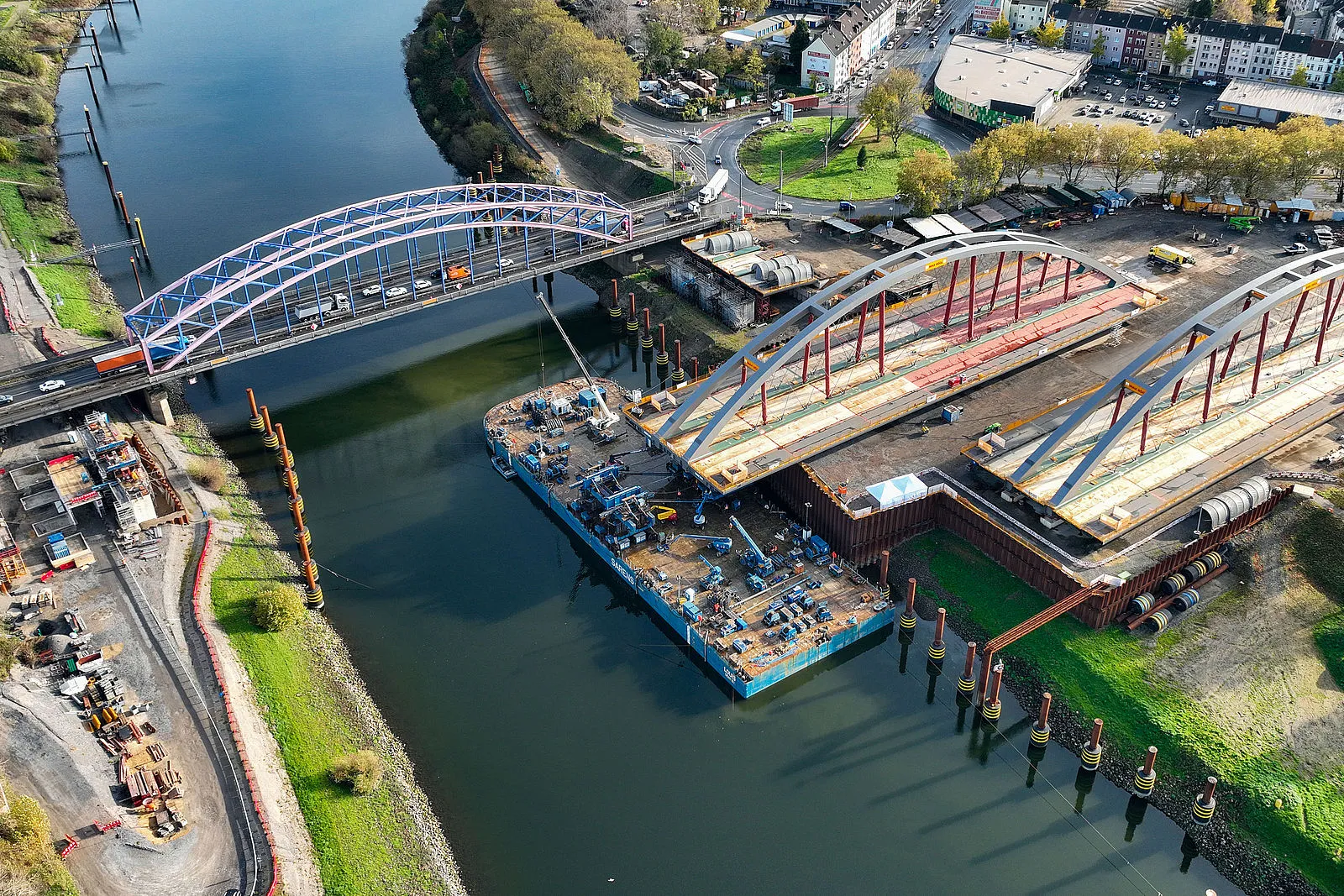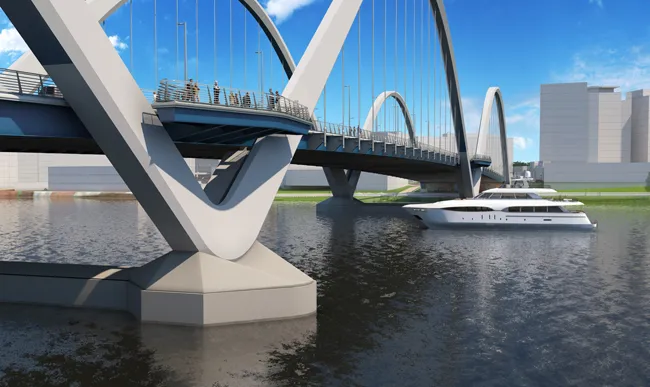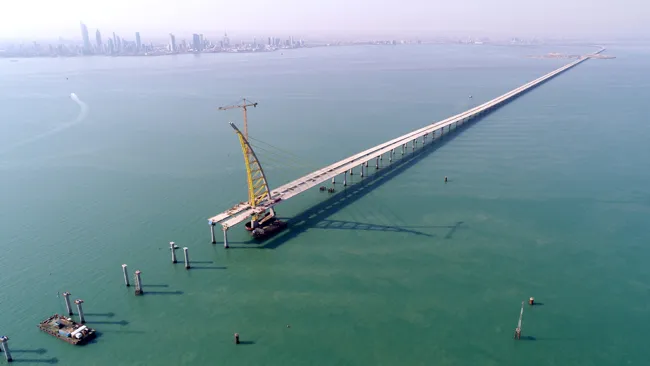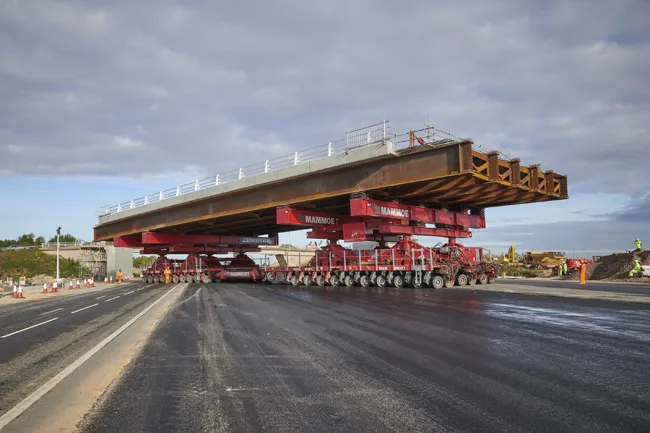
The client was Max Bögl, a multinational construction company based in Sengenthal, Germany. During the autumn and winter of 2022, Max Bögl asked Sarens to install the Oberbürgermeister Karl Lehr Brücke (OBKL - Mayor Karl Lehr Bridge) over the Ruhr River and the Hafenkanalbrücke which was to span the canal that leads to the Port of Duisburg.
Mayor Karl Lehr made outstanding contributions to the expansion of the Duisburg-Ruhrort ports, turning them into world-class inland logistical infrastructure. The old OBKL bridge, which opened in 1949, was one of only three inner-city north-south connections across the Ruhr River. It was an important axis for traffic and the main artery for the port of Duisburg and associated logistical traffic.
The old bridge was so vital to the city’s daily functioning that without it, city officials said, traffic would be gridlocked, the port would be deprived of its primary road access and normal traffic flow - as well as local public transport - would come to a standstill.
For these reasons, the new OBKL bridge is of particular importance. But it is a massive 4,400tonne structure of steel measuring 25m high, 34m wide and 180m long and included the approach bridges. It was to replace the old structure connecting the Kaßlerfelder roundabout with the Pontwert.
The other steel bridge Sarens was tasked with installing was the new Hafenkanalbrücke, weighing around 3,650tonnes. It measures 25m high, 34m wide and 126m long. It was to replace an old structure connecting the Pontwert to Mercator Island.
Installation posed significant challenges, not the least of which was skidding heavy bridge sections within a limited operational window that left no room for error. There was also limited space to set up equipment for the operation. Furthermore, the crew had to adjust to wind restrictions and very low water levels.
The solution
Sarens decided to use a combination of techniques and equipment, deploying a barge, SPMTs (self-propelled modular transporters), strand jacks, skidding systems and various climbing systems to safely install both bridges. The engineering team worked out all the calculations and drawings to skid the heavy bridge sections into place, despite the low water levels.
After numerous calculations and meticulous planning, the team shortlisted the following equipment:
Barge Paula (100m x 33m x 7.6m)
68 axle-lines SPMTs
12 x SJ200T strand jacks
8 x CS450 jacking system
16 x CS250T jacking system
Modular beam system, 1500mm x 1000mm
Bracing systems
Skidding system
All equipment was set up within six weeks. Everything, except the barge, was transported via 75 truckloads from Sarens headquarters and various yards in Europe. The barge Paula was transported by tugboats over the North Sea and the River Rhine. The team also had to find solutions for bringing the strand jack cables over the water, using 12km of strands for the job.
Sarens first conducted preparation and testing before transporting the bridges into position. The steel bridge parts were delivered by ship by client Max Bögl, and then assembled into bridge structures on the pre-assembly area next to the distribution circuit. When the assembly of both bridge superstructures was complete, they were then partially loaded onto Sarens SPMTs and skidded over the floating barge Paula.
The operation
The Hafenkanalbrücke was the first bridge to be installed. The crew carefully skidded the bridge section, using strandjacks and skidshoes, onto Paula. Next, the loaded barge was moved about 100m ahead with winch cables so that the bridge could be skidded over the barge on skidshoes installed on the island. The crew skidded the whole bridge over the island and parked it there, between the Rhine and the port canal.
In the meantime, the barge sailed around to the port canal, where the crew skidded the bridge back onto the barge via strandjacks and a skidding system. Once it was completely loaded, winch cables moved it into its final position. The bridge was then lowered onto the abutments by means of a jacking system.
Next, Paula moved back to the Rhine to skid the OBKL bridge onboard in a similar manner. The bridge was then positioned by means of winch cables and lowered onto the abutments with a jacking system.
The team had to skid both bridges into place within a limited timeframe, in a very complex and difficult operation. To ensure safety throughout, the crew handled the extremely heavy bridge sections in a very slow and precise manner.
Wind and water level restrictions further compounded this challenge. This meant that the crew had to closely monitor the barge Paula to ensure stability of the entire set-up, given the low water levels and bridge sections to be installed.
The two bridges are currently floating in their temporary bypass position and will replace the old bridges once they are dismantled.
The new Oberbürgermeister Karl Lehr Brücke was opened to trams, motor vehicles, cyclists and pedestrians in December last year. A tram has a separate track between the two lanes in each direction and there is a separate pedestrian and cycle paths on both sides.









